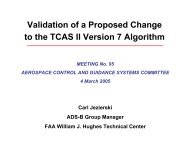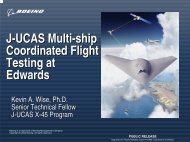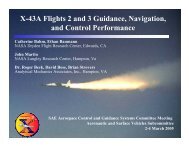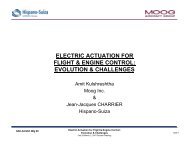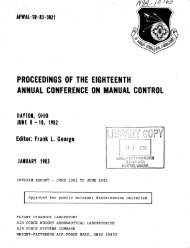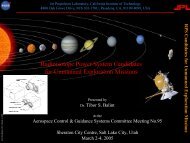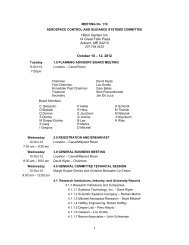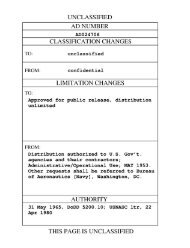Report of the Second Piloted Aircraft Flight Control System - Acgsc.org
Report of the Second Piloted Aircraft Flight Control System - Acgsc.org
Report of the Second Piloted Aircraft Flight Control System - Acgsc.org
Create successful ePaper yourself
Turn your PDF publications into a flip-book with our unique Google optimized e-Paper software.
to <strong>the</strong> piston. When <strong>the</strong> spool member is displaced from <strong>the</strong> neutral position<br />
by mvement <strong>of</strong> <strong>the</strong> input lever at point (A), <strong>the</strong> flow <strong>of</strong> fluid<br />
through <strong>the</strong> pilot valve causes <strong>the</strong> piston to move in <strong>the</strong> direction which<br />
returns <strong>the</strong> spool to <strong>the</strong> neutral position. It follows from <strong>the</strong> geometry<br />
<strong>of</strong> <strong>the</strong> linkage that for every position <strong>of</strong> <strong>the</strong> linkage point (A) <strong>the</strong>re is<br />
a corresponding equilibrium position <strong>of</strong> <strong>the</strong> piston. The description <strong>of</strong><br />
several o<strong>the</strong>r forme <strong>of</strong> pilot valving and feedback linkage is available<br />
in <strong>the</strong> literature.<br />
Rotary servomotor. - The rotary servomotor is also shown schematically<br />
in figure 1. Rotation <strong>of</strong> <strong>the</strong> pilot valve with respect to <strong>the</strong> output shaft<br />
opens a pressure passage to one side <strong>of</strong> <strong>the</strong> vane and a drain passage to<br />
<strong>the</strong> opposite side <strong>of</strong> <strong>the</strong> vane. The vane is <strong>the</strong>reby caused to rotate in<br />
<strong>the</strong> same direction as <strong>the</strong> pilot valve. In <strong>the</strong> neutral position '<strong>of</strong> <strong>the</strong><br />
valve <strong>the</strong> passages to ei<strong>the</strong>r side <strong>of</strong> <strong>the</strong> vane are closed.<br />
Initial assumptions. - The analysis which follows is developed with<br />
<strong>the</strong> following initial assumptions t<br />
1. The area <strong>of</strong> opening <strong>of</strong> <strong>the</strong> pilot valve varies liaearly with <strong>the</strong><br />
motion <strong>of</strong> <strong>the</strong> valve.<br />
2. At fixed input, <strong>the</strong> ratio <strong>of</strong> pilot valve mvement'to piston mvemnt<br />
is constant.<br />
3. At all positions <strong>of</strong> <strong>the</strong> pilot valve <strong>the</strong> inlet and discharge openings<br />
are equal.<br />
4. The supply and drain pressure are constant.<br />
5. The compreseibi~ty and mass <strong>of</strong> <strong>the</strong> hydraulic fluid are negligible.<br />
6. Structure and mechanical linkage are rigid.<br />
7. Mechanical fraction is negligible.<br />
'8. Fluid friction losses in motor passages are negligible.<br />
9. Leakage is negugible.<br />
Response to a Step Input<br />
Baeic dynamic considerations. - Under <strong>the</strong> condition <strong>of</strong> no load on <strong>the</strong><br />
output shaft and negligible internal motor mass, <strong>the</strong> pressure drop across<br />
<strong>the</strong> piston will be zero. The fluid flow through <strong>the</strong> cylinder is <strong>the</strong>refore



